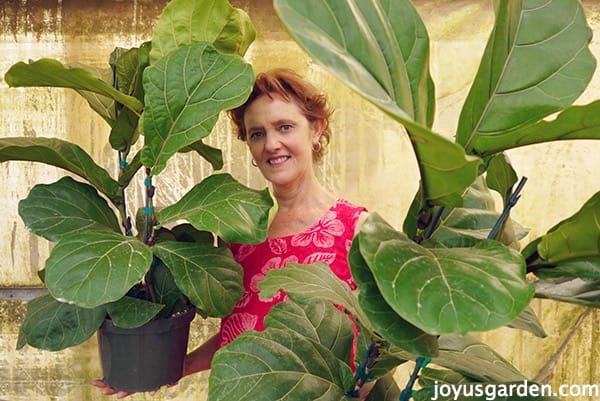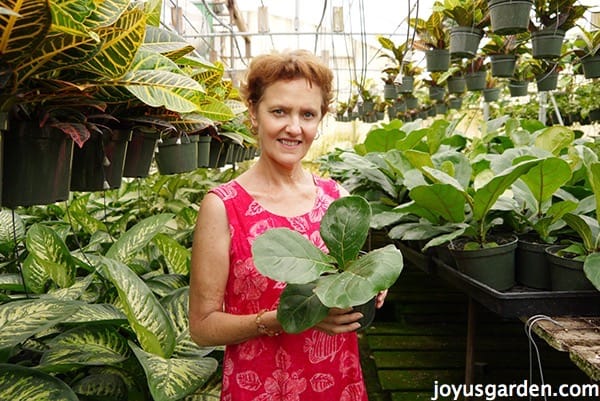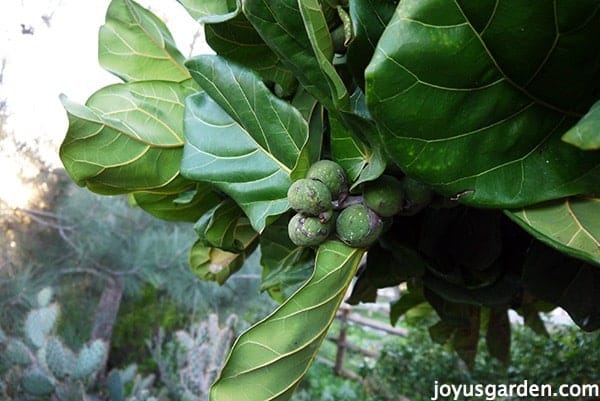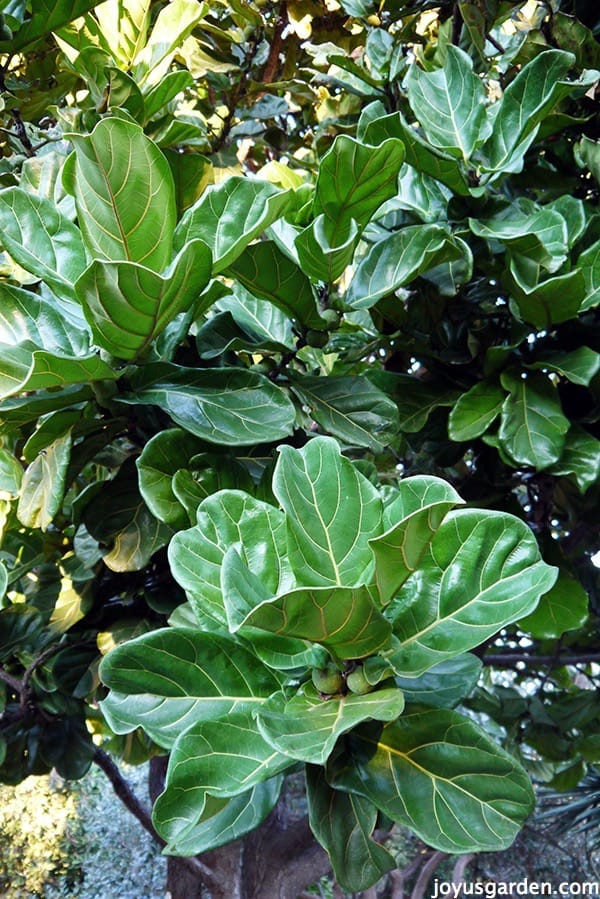Fiddleleaf Fig: Care Tips For This Fabulous Houseplant
I love Fiddleleaf Figs! They’re definitely a houseplant that makes a statement. Their huge foliage makes my heart go pitter-patter. Here, you’ll find plenty of Fiddleleaf Fig care tips.
The Fiddleleaf Fig, or Ficus lyrata, is one of my very favorite houseplants and always has been. I’m crazy for its huge, tough, leaves which are shaped like violins and look like road maps.
The Fiddleleaf Fig plant is especially favored by people by those who are fans of a groovy, modern environment. I believe it would fit into a Palm Springs lounge with ease. It has a very different look from its more common leaf-laden Ficus benjamina cousin, that’s for sure.
Some Of Our General Houseplant Guides For Your Reference:
- Guide To Watering Indoor Plants
- Beginner’s Guide To Repotting Plants
- 3 Ways To Successfully Fertilize Indoor Plants
- How to Clean Houseplants
- Winter Houseplant Care Guide
- Plant Humidity: How I Increase Humidity For Houseplants
- Buying Houseplants: 14 Tips For Indoor Gardening Newbies
- 11 Pet-Friendly Houseplants
Be sure to watch the video below which was shot in a grower’s greenhouse for more care tips. There’s a bit of noise in the background but that’s the water running down the walls which is part of the cooling system as well as ventilation fans. These plants grow outdoors here in Santa Barbara so if you stroll all the way to the bottom, you’ll see pictures of one in the great outdoors.
You can find the Fiddleleaf Fig in various forms like single-stemmed, multi-stemmed, full to base and standard (that’s industry-speak for “treelike”). As they age, the lower leaves tend to fall off and their stems twist and gnarl a bit. Quite a cool look.
Here’s the encapsulated version of what they need:
Light
Medium to high. One reason why they die or look bad is not enough natural light.
Water
Average. More on watering houseplants here.
Fertilizer
I give most of my houseplants a light application of worm compost with a light layer of compost over that every spring. Easy does it – 1/4 to 1/2? layer of each for a larger sized houseplant. Read about my worm compost/compost feeding right here.
Pests
They’re susceptible to mealybugs & scale.
If you want more info on this plant and many others, which you’ll welcome into your home, please check out our book Keep Your Houseplants Alive. It’s a practical guide written in simple terms with lots of pictures.
Happy (houseplant) gardening,


This post may contain affiliate links, you can read our policies here.
- About the Author
- Latest Posts
Nell, the founder of Joy Us garden, was born into a gardening family and grew up in Connecticut’s countryside. After living in Boston, New York, San Francisco, & Santa Barbara, she now calls the Arizona desert home. She studied horticulture & garden design, working in the field all her life. Nell is a gardener, designer, blogger, Youtube creator, & author. She’s been gardening for a very long time & wants to share what she’s learned with you.











What’s the age of the one out doors? Is the fruit eatable?
Thanx
Hi Michael – All Ficus’ fruit but the only Ficus carica, the Common fig, is eaten by us humans. The good-sized fruit of the Ficus lyrata is not edible but it’s not poisonous either. I’m not certain, but perhaps some birds enjoy them. Nell
They are fabulous specimens. My friend planted his little houseplant fiddle in the center of his south Florida yard and now he can’t see the street, it is so happy! (And so is he.)
Rennie
Aren’t they beautiful Rennie? They grow like crazy outdoors here & most likely enjoy south Florida even more. What a wonderful plant to screen out the street! Nell
Nell, your neighbors that have the fiddle tree plant outdoors. Is it in full shade? I may want to do that in my backyard too here in SB. Thanks, Patti
Hi Patti – My neighbor’s FF gets morning & early afternoon sun. At SBCC, there’s one about 30′ tall in full sun. This one, however, is showing signs of stress because of our drought. They grow in Hawaii in full sun but get much more moisture. To answer your question, it would be fine in full sun (no reflected heat though, ie, up against a south facing wall) if you water it regularly & deeply. The problem these days is that we haven’t gotten adequate winter rains. I hope that helps! Nell
Please tell me how I can propagate a fiddle leaf fig tree from a cutting 🙂
Hi Annie – I’ve found the best way to propagate a Fiddleleaf Fig is by air layering. You can also propagate a 8-12″ cutting in a light mix. Just be sure to remove most of that big foliage. Hope that helps, Nell
thank you for the video. I bought one! Live in the desert with very low humidity. Is it doomed? Thanks for your help.
Hi Gabby – You’re certainly welcome! I just moved to the desert & my Ficus elastica (Rubber Tree) is doing just fine. These tend to be a bit easier than the Ficus lyrata which you have. It’ll be fine but you’ll probably get dry leaf edges from the lack of humidity. I grow orchids here in the desert & have trays filled with pebbles & water underneath each 1. You might consider doing that to boost the humidity around your new baby a bit. Just don’t let the roots sit in water! Nell